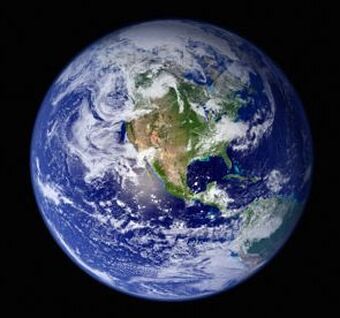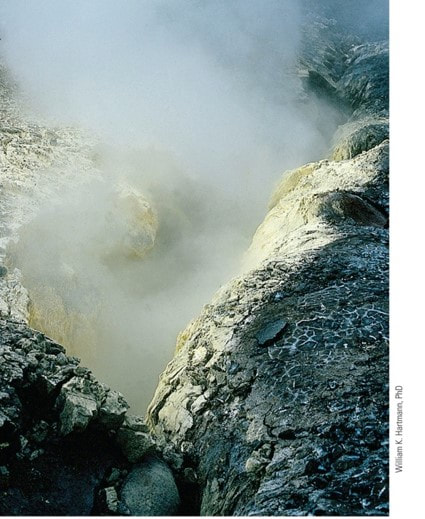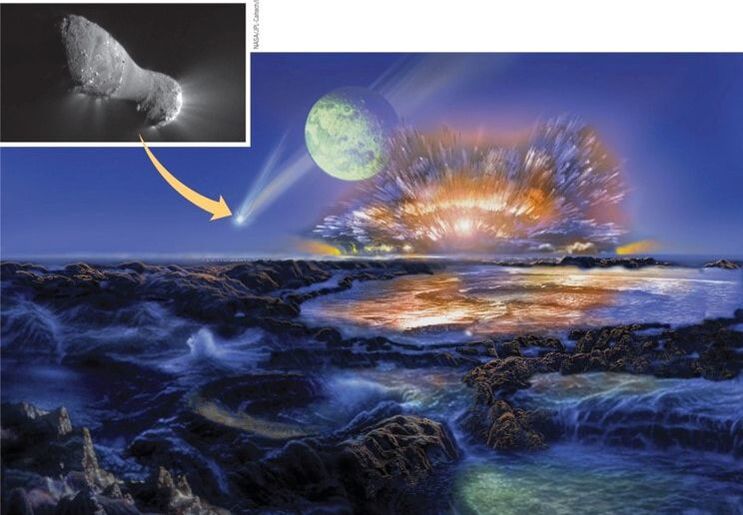|
Oceanography >> The World Ocean >> The Size and Origin of the Ocean
|
1.4 - The Size and Origin of the Oceans
Objectives:
- To appreciate that the world ocean covers some 70 % of the surface of the Earth.
- To know that the mean depth of the ocean is about 3,700 m, with a maximum depth of nearly 11,000 m.
- To know one of the theories for the origin of the ocean.
|
On a human scale, the oceans are vast. It took me 18 days to sail from the Canaries to St Lucia, and that is not even close to the whole way around. They are also scarily deep, on average the North Atlantic is 3,600 m deep - that is nearly 4 km (the distance from the Flag Pole on Front Street to Spanish Point).
However, lets see this on a globe. The globe in my lab is 40 cm diameter. If the radius of the Earth is 6370 km, the scale is 1 km = 0.063 mm. So the mean depth of the Atlantic on my globe would be 0.23 mm - the thickness of a coat of paint. The atmosphere is not much bigger, while it is about 300 km thick, the majority of the interesting stuff is in the troposphere - the lowest 10 km or so. This would be about 0.63 mm. Suddenly all that stuff about the fragility of the atmosphere and oceans seems to make a bit more sense. |
|
|
The total volume of the ocean is \(1.335\times10^9\,\text{km}^3\). If, as the video suggests, all of that water was to be gathered up into a single ball, what would be its diameter? Remembering that the volume of a sphere is:
\[V=\frac{4}{3}\pi\,r^3\] A quick bit of maths yields a radius of \(683\,\text{km}\), which leads to a diameter of \(1366\,\text{km}\). This is about 11 % of the diameter of the Earth. |
|
No one really knows how the ocean was formed but there are a number of good theories. The biggest question by far is where did the water come from? The working theory is that as the Earth cooled from a ball of molten stuff, the heavy elements like iron and nickel migrated to the core and the lighter elements either vented to space (hydrogen and helium), formed an atmosphere and the crust. Much of the hydrogen had oxidised to form water vapour, which is heavy enough to be held by the Earth’s gravity. As the Earth cooled, this vapour condensed to form liquid water. It could have come from icy meteorites hitting the primordial Earth. Another theory is based on the discovery that comets are in fact ‘dirty snowballs’ in space. The origin of these is a bit of a mystery. If, early in the formation of the Earth a number of these comets hit the planet, it would have provided the water. There are a few problems with these theories involving other trace elements and isotopes. The two comets that have been studied in detail have higher ratios of heavy hydrogen (H-2) and meteorites do not have enough xenon to explain the concentrations found on Earth. The outgassing of water vapour during the formation of the planet has issues as Mars appears to have little or no surface ice, but unlike Earth Mars does not have the same tectonic plate movement, which would cause breaks in the crust that would lead to outgassing. So, the likelihood is that the answer is probably a mixture of all three theories…
|
|
|
Activities:
|
Reference: https://manoa.hawaii.edu/exploringourfluidearth/physical/world-ocean/map-distortion/activity-how-much-water
Reference: Scientific American Article 1997
| ||||||
|
|
|


